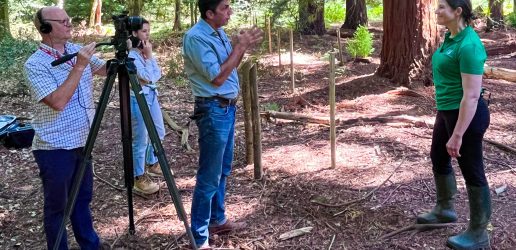Following a significant investment by Defra, much of the TreeAlert system has been rebuilt. TreeAlert has been given a new look with responsive web design, adapting to mobile devices to make it more user friendly and has increased functionality including

The reports are checked daily by Forest Research’s Tree Health Diagnostic and Advisory Service (THDAS), triaged and assigned to a diagnostician within the THDAS. The THDAS provides impartial advice, and where possible, diagnosis and identification of pests and pathogens on trees in Great Britain. The service has been running since the 1960s, and enquiries and samples are received from across Great Britain and occasionally further afield. The team of diagnosticians, entomologists and pathologists is located at Forest Research’s two main research stations – the Northern Research Station in Scotland and Alice Holt in southern England.
Once reviewed, the diagnostician assigned to your enquiry in some cases will make a diagnosis based on initial information, request further information or samples, and this will be done generally via email. The team aim to respond to enquiries within two weeks, although this can be significantly longer during busy periods or based on the nature of your enquiry. Priority is given to any suspected regulated or quarantine pest or pathogen, and these cases may be followed up by the wider Plant Health Service (the respective authorities in England, Scotland and Wales) with whom the THDAS closely collaborate with.

The role of the THDAS is to gather information about the health of the nation’s trees (individually or in woodlands and forests), to assess findings and identify trends in pest and pathogen occurrence and spread, and to contribute towards the management of these through providing advice to owners, managers and the relevant authorities. The THDAS acts as an early warning system for tree health; if pests or pathogens are detected and reported early, there is a greater prospect of managing or controlling them. Interesting findings or first reports of organisms result in further studies including examining the range of potential hosts or optimal temperature conditions for growth, and ultimately can develop into dedicated research projects.
We encourage the reporting and are interested in sightings of all pests and pathogens so we can monitor trends and provide authorities and tree owners with the best possible opportunity to take appropriate action. It is better to reassure you that there is no cause for alarm or your problem is commonplace than to miss a possible new threat to British trees.
Please remember….
Further information on tree pests and pathogens can be found on the Forest Research and Observatree websites.
Cumbria-based land managers and local landscape decision-makers sought for research about ticks.

Dr Gail Atkinson was interviewed by the BBC’s Climate Editor, Justin Rowlatt, as part of a news item on climate change and the launch of latest Met Office State of the UK Climate Report.

The British Woodlands Survey, 2025, which focuses on resilience launches.
Cumbria-based land managers and local landscape decision-makers sought for research about ticks.

Dr Gail Atkinson was interviewed by the BBC’s Climate Editor, Justin Rowlatt, as part of a news item on climate change and the launch of latest Met Office State of the UK Climate Report.

The British Woodlands Survey, 2025, which focuses on resilience launches.